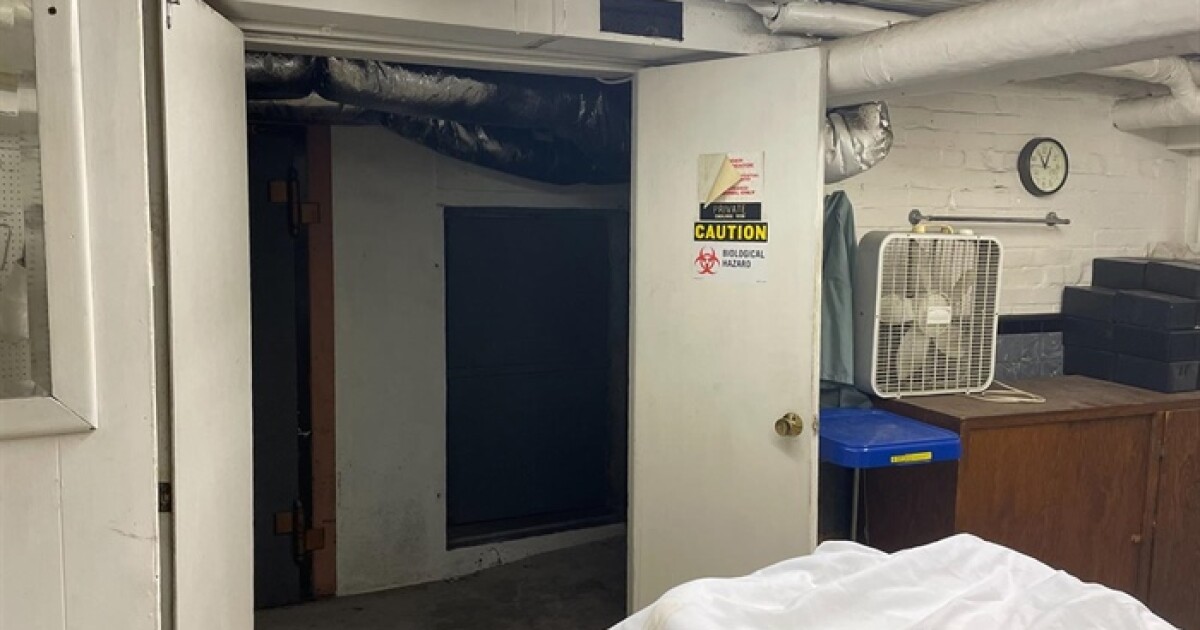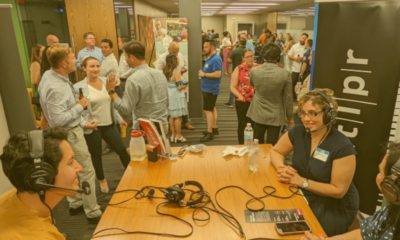Business
Tech job listings decline puts focus on St. Louis startups
The effort to substantially grow the region’s technology workforce is facing stiff headwinds.St. Louis is dealing with some of the national employment trends in the sector, like layoffs and companies cutting back on hiring new positions.From 2022 and 2023, the total number of active job listings for tech positions dropped 45%, according to a March report from TechSTL, the region’s tech council. The report also finds the St. Louis region had steeper drops in active listings compared to the U.S. as a whole in that same time period.As stark as this news was for TechSTL Executive Director Emily Hemingway, it also offered a sense of relief, she said.“When this [report] came out, it was really validating for all of us because we had seen in life, in reality, that things had shifted,” Hemingway said.She cites two culprits for the current contraction: an end to the pandemic hiring spree in tech and the explosive growth of artificial intelligence prompting some companies to become leaner.While the report found the number of active job listings dropped dramatically between 2022 and 2023, overall employment in the local tech industry ticked up slightly, by 2%.This comes as the U.S. Bureau of Labor Statistics anticipates some tech-sector occupations like software developers, information security analysts and data scientists, will grow as much as 35% by 2032 compared to about 3% growth for all occupations in the country.Hemingway said that means the underlying skills for a technology-focused role are still in demand, just maybe not at a large firm.“When you have significantly fewer jobs, you can’t be dependent on our large anchor institutions or corporate partners to really drive the workforce,” Hemingway said. “These jobs that are being cut are largely in these larger hiring agencies.”She said the St. Louis region needs to prioritize the development and growth of local startups and entrepreneurs as a way to support the existing tech talent in the region.“If we can’t find these folks a good way to make money in St. Louis, they will either change their industry or they will change their town,” Hemingway said. “It is a race to support what we have here and give them a reason to stay in St. Louis.”
Eric Lee
/
St. Louis Public RadioResident companies are listed on a sign late last month in St. Louis’ Cortex district.
‘A lot of fluff in the startup ecosystem’An innovative idea typically forms the basis of new startups, but there can be a downside to focusing too much on pitching them, said Christian Johnson, who runs the geospatial startup Metis Analytics, which provides workflow management software for intelligence analysts.In the 8½ years that Johnson’s been involved in the local startup scene, he said he’s seen some organizations catering to startups favor pitching and promotion over concepts like how to build and scale a new venture.“There’s a lot of fluff in the startup ecosystem,” he said. “It becomes a fashion show basically, instead of it being about can you actually build a product that people want and that will buy from you?”Johnson also runs Founders Lounge, a weekly forum where entrepreneurs of any experience level can discuss their ideas and any obstacles they’ve faced. It also has events that bring in speakers from other cities who shed light on marketing, sales and the technical sides of a business, like choosing a cloud database or how to incorporate large language models into an application, he said.“Just different things that will help move the needle in your business that actually do help,” Johnson said.Spaces for these kinds of interactions are vital, yet lacking in St. Louis, he said, that adding other markets in the U.S. have established places like these.“This is not something that is foreign but something that is super powerful that we’re bringing to St. Louis,” he said.
Brian Munoz
/
St. Louis Public RadioGabe Angieri, Arch Grants’ executive director, at St. Louis Public Radio’s headquarters in Grand Center.
Financing and customersBeyond more programming to help startups with their business strategy, there’s the sticking point of securing local capital or customers that will invest in or buy a local company’s product.It’s something Arch Grants specifically looks for when vetting the companies it eventually supports, said Executive Director Gabe Angieri. The nonprofit awards grants to companies with high growth potential in St. Louis that are either already located in the region or that will relocate here, he said.“We want companies that see their long-term path to success in St. Louis and this region,” he said. “We put a high barrier to entry on that.”It helps when a startup, local or otherwise, can clearly articulate potential partners, customers or when it can point to people in the St. Louis region who have weighed in on its business plan or innovation, Angieri said. Locating capital and customers are frequent challenges for new ventures in the region, he added.“St. Louis is an extraordinarily generous city — there’s a lot of wealth in this region,” Angieri said. “It is not the most adventurous when it comes to investing in early-stage startups. And it is a high-risk endeavor, no question about it.”There is a push at the state level for tax credits for angel investing that could entice more early-stage investing. But even in the local biosciences sector, which has examples of successful startups that are now standalone companies or were acquired, lots of capital can be hard to come by.“There’s just fewer examples of people taking giant home run swings and succeeding,” said Tom Cohen, chief operating officer at Panome Bio, a local biotech startup.This can push local startups to look for capital or customers elsewhere, likely from the coasts, and that can leave startups asking, “Why am I here?” if their financial support is elsewhere, Angieri said.One solution he sees is in some of the existing large corporations in St. Louis working directly with local startups in addition to the dollars they already dedicate to organizations like Arch Grants, he said.“It’s shifting from a mindset of community-based philanthropy to a more risk-tolerant approach,” Angieri said. “To see the solutions and the innovations come out of the startup sector as viable options as you seek to address pain points in your own companies.”If local corporations started dedicating a portion of their budget to pilot with startups in St. Louis, it could unlock considerable growth for small to midsize ventures in the region, he said.
Eric Lee
/
St. Louis Public RadioPeople play a card game during a networking event hosted by Founders Lounge late last month at Aloft St. Louis Cortex Hotel.
‘Right now we’re whispering’Entrepreneurs are also responsible for driving this shift in perspective for local companies, argues Chris Ocasio, a server and bartender who’s recently started developing apps.“If we want them to listen, then we have to speak,” he said. “And right now we’re whispering.”When Ocasio first decided to pursue his own venture less than a year ago, he said he was struck by the level of support he received.“Two years ago, a year ago, I had no idea there was this type of ecosystem in St. Louis,” he said. “Everyone was excited to see someone hungry to get into the entrepreneurial space.”Ocasio argues not enough people or companies in the broader St. Louis community are aware of the innovations people like him are working on or how they can get involved in the community if they wanted to.“There’s no TikTok’s about this, you know? Like why can’t we do that,” he said. “We need to show that pride and get St. Louis talking about the fact that there’s innovators here, [that] we’re hungry [and] going to make it happen.”
National Geospatial Intelligence AgencyThe exterior of the new National Geospatial-Intelligence Agency in north St. Louis. The agency has plans to collaborate with more outsider organizations, academic institutions and private industry when its new headquarters in St. Louis fully opens in 2026.
A blueprint for successLeaders across St. Louis don’t have to look far for a potential blueprint on how to respond to the current job environment in the technology sector. The biosciences sector experienced a similar contraction about 20 years ago, said Justin Raymundo, BioSTL’s director of regional workforce strategy for the bioscience sector.“In the early 2000s, we really didn’t have what we would call a thriving entrepreneurial ecosystem or an innovation economy,” he said. “We focused particularly on having large corporations or large academic institutions.”St. Louis saw large companies leave the area or get acquired by firms outside the region, Raymundo said. The strategic response to this and the urban depopulation of the time was to create the Coalition of Plant Live Sciences (the precursor to BioSTL) that would focus on developing an ecosystem to support homegrown innovation in the biosciences and cushion against corporate downsizings, he explained.Two decades later, that strategy has paid off and led to key drivers of innovation in the Cortex Innovation District, BioGenerator Ventures, a dedicated fund for investing in and building biotech startups, and other markers of a healthy startup system where new ventures are making successful exits, he added.“That’s a story of how anchors came together in this community at a point when we really needed to invest,” Raymundo said.But it wasn’t cheap or necessarily easy, he added.“What we’re demystifying now is that a lot of this requires investment, particularly philanthropic investment, state and local investment, private-sector investment,” Raymundo said. “We’ve reached this point in our region over 20 years of a lot of patient capital and commitment.”Johnson, of Metis Analytics, said it’s worth it for St. Louis to make similar pushes now for other sectors like geospatial or artificial intelligence.“We have to do that,” he said. “There are more geospatial startups that are coming here from out of town. But also there needs to be more geospatial startups that are starting from here.”The National Geospatial Intelligence Agency has plans to collaborate with more outsider organizations, academic institutions and private industry when its new headquarters in St. Louis fully opens in 2026.It could create similar conditions in the biotech sector now, where ideas can spin out into new ventures, said Cohen with Panome Bio.“That seems like something that could really blow up,” he said. “And could be the nucleus that creates a whole new sector. We could become the space to build geospatial companies.”
Business
New owner of vacated Centralia funeral home makes a startling find

In the basement of a Centralia funeral home in a dark hallway off the embalming room, tucked inside a nook behind two steel plates and a door, a visitor found three disembodied, neatly wrapped human legs, two of them marked with names and dated to the 1960s.The discovery stunned property owner Cindy Hansen, who had been cleaning up at the site of the former Moran Queen-Boggs funeral home for weeks. After all, she’d seen her last tenant evicted, his funeral director license suspended for the home’s filthy conditions – which included a dead rat in a stairwell.But as the shock dissipated on what first appeared to be a grisly find, a more mundane explanation materialized – the legs were likely the result of amputations, stored away decades ago until their owners died and they could be reunited and interred together, said Jay Boulanger, who has operated a funeral home in Highland for decades.“In those days, hospitals didn’t treat that as medical waste and cremation wasn’t popular then, so they just embalmed them and held on to them. Sometimes, people don’t get them, so they just stay,” Boulanger said.The discovery was made at the former funeral home operated by Hugh Moran in recent years, but he surrendered his license in March after state regulators found his facility in deplorable condition. But the hidden nature of the room and the fact that two of the legs were dated decades before Moran operated the facility indicate he was not involved in placing them there.Moran vacated the building last month, and Hansen began scrubbing and filling two large dumpsters with trash. After weeks of work, Hansen was seeing progress.Two casket salesmen came to pick up a display last week and asked her for a tour of the historic home with ornate oak woodwork and stained-glass windows, built by a cigar magnate in the late 1800s at the corner of South Elm and East Second streets in Centralia.On the tour, one salesman kept returning to that steel door in the dark hallway just off the embalming room.“Finally, he got a pair of pliers and turned the bolt to open it,” Hansen said. “There was another plate, so he opened that, too. Then, he got to the door and looked in. He backed up and said, ‘There’s legs in there.’”The three stood for a moment, then closed the door, returned the plates, and pondered what to do next.“I was completely freaked out,” Hansen said.But her shock at the situation did not raise any immediate response. She called the Illinois State Police, who called the Marion County coroner, who advised her to lock up when she left on May 7 and they would get back to her. The legs remained at the funeral home as of Tuesday, but the coroner said he will be getting them soon, Hansen said.In late February, three days after Capitol News Illinois sent questions to the department about an unanswered December 2023 complaint that the embalming room looked “like something from a scary, filthy, freak show,” the Illinois Department of Financial and Professional Regulation inspected the building.Inspectors didn’t disturb the steel plates blocking the nook with the legs, but they did find that Moran had maintained the embalming room in “extremely unsanitary conditions,” and he agreed to surrender his funeral director license permanently. Photographs of the room submitted with the complaint depicted a water leak, piles of dirty laundry and medical waste, along with the dead rodent.The conditions at Moran’s funeral home became public within months of a discovery that a Carlinville funeral home provided the wrong ashes to at least 80 families, spawning lawsuits and legislation.Sen. Doris Turner, D-Springfield, introduced legislation called “Reestablishing Integrity in Death Care Act” after that discovery resulted in at least nine exhumations, including five from Camp Butler National Cemetery in Springfield. No criminal charges have been filed against the funeral director responsible for those remains, August Heinz.Senate Bill 2643 codifies best practices already in place by most funeral homes, mandating that a unique identifier must be put on the deceased’s body and any other associated human remains. Under the proposal, a director must also document the chain of custody for all bodies and human remains.The bill also mandates that the state must respond to complaints within 10 days and gives authority to remedy the complaints, including inspecting the funeral home premises.That bill is awaiting a vote in the House.Clean-up at the former Moran-Boggs continues.But the name on the sign outside will soon change. Funeral Director Vonda Rosado will take over and change the name to Maxon-Rosado Funeral Home, the same as her other funeral home in DuQuoin. She plans to hire a professional to clean the embalming room.“We want to restore the history and integrity of this beautiful facility,” she said.Capitol News Illinois is a nonprofit, nonpartisan news service covering state government. It is distributed to hundreds of newspapers, radio and TV stations statewide. It is funded primarily by the Illinois Press Foundation and the Robert R. McCormick Foundation, along with major contributions from the Illinois Broadcasters Foundation and Southern Illinois Editorial Association.
Business
Illinois State Vet: Bird flu no threat to milk or food supplies

Two weeks after the U.S. Department of Agriculture implemented mandatory testing and reporting for interstate movement of dairy cattle in response to the spread of bird flu within the nation’s livestock sector, there are still no confirmed cases of the H5N1 influenza virus in Illinois.This is according to Illinois Department of Agriculture State Veterinarian Mark Ernst, who said dairy cattle producers were asked to implement safety protocols to prevent spreading the strain of highly pathogenic avian influenza [HPAI], whose presence has been detected in the nation’s milk supply.“H5N1 was first detected in livestock in Texas. The thought is that they were exposed to perhaps wild birds, which were able to transmit it over to cattle,” said Ernst, a Washington, Illinois, native who has served as state veterinarian for about the last 20 years. “In Illinois, we have not had any detections so far in our dairy herd. There are nine other states that have had detections on 36 premises.”There have been no confirmed U.S. detections of H5N1 in livestock reported since the USDA issued the mandatory testing and reporting protocol in late April, said Ernst, adding mortality rates among infected livestock have been low to non-existent.“It seems the cows recover over a period of time, though it may take upwards of a month,” said Ernst. “They do come back in their milk; however they don’t appear to be milking at a level where they were before they became infected.”
Illinois Department of Agriculture State Veterinarian Mark Ernst.
Illinois milk producers have been stepping up their biosecurity measures and limiting farm visitors since the H5N1 outbreak gained momentum several weeks ago while monitoring for telltale signs of the virus in their cattle.According to guidance issued to dairy cow producers on Tuesday, the USDA mandates that producers report animals with the following clinical signs to their state veterinarian immediately: decreased herd level milk production; acute sudden drop in production with some severely impacted cows experiencing thicker, concentrated, colostrum‐like milk; decrease in feed consumption and lethargy, dehydration and fever, among other symptoms.However, some cattle may present asymptomatically yet still harbor the H5N1 virus.“You’ve got to be really careful right now introducing new stock to the herd. It would be advisable to isolate incoming animals,” said Ernst. “The other thing that applies to more than just H5N1 is good biosecurity. You’ve got to limit farm traffic to essential traffic, and have good disinfectant cleaning of equipment and buildings. You also must limit the access of wildlife to feed sources and water sources.”Scientists are working to discover the pathway the virus takes in infecting cow milk. Reuters reports scientists suspect the virus can spread between cattle during the milking process, either through contact with infected equipment or with a virus that becomes aerosolized during cleaning procedures.“For whatever reason, the virus has had an affinity, more or less, for the udder and for milk,” Ernst said. ‘Fortunately, pasteurization has shown so far to be effective at destroying the virus in milk. The consumption of pasteurized dairy products doesn’t seem to be a risk at all to the public.”An IDOA news release noted the U.S. Food and Drug Administration has announced the commercial milk supply is believed safe due to the pasteurization process that destroys bacteria and viruses in milk. Protocols also are in place to destroy milk from affected dairy animals, according to Illinois Department of Public Health Director Dr. Sameer Vohra.“IDPH prioritizes the safety of our milk supply as well as the Illinoisans who work with cattle and poultry,” said Vohra. “Please note that pasteurized milk is safe, but we strongly recommend that Illinoisans avoid any unpasteurized raw milk products at this time based on the potential risk of infection.”The virus seems to be contained exclusively to dairy cattle at this point, Ernst observed. “At this point in time, there have been no reports of the virus in beef cattle. That could change; this is evolving and we’ve got to be vigilant.”Though the risk to livestock and the nation’s milk and food supplies may be nominal, the Center for Disease Control reported on Wednesday that the first case of human H5N1 infection has been confirmed in a Texas dairy worker.While the current public health risk is low, the CDC is watching the situation carefully and working with states to monitor people with animal exposure. In addition, the CDC is also beginning to monitor wastewater for signs of the virus and will issue a public report soon.Illinois is home to more than 600 dairy farms with 73,000 cows or calves, according to the USDA National Agricultural Statistics Service.
Business
University City entrepreneurs bake for college and a cause
For veteran bakers and baking novices alike, perfecting the classic chocolate chip cookie is no simple feat. The perfect bite is a confluence of textures, an artful balance between salty and sweet and slightly bitter, all of which come to fruition with quality ingredients and impeccable technique.Maya, 11, and Nadia Turner, 13, have not only come to the perfect recipe, but are sharing their confections with loyal customers. The University City sisters are the founders of Chocolate Girls’ Cookies and have been selling cookies since 2019.
Chocolate Girls’ Cookies signature chocolate chip cookie. The sisters
The Turners were inspired to form the LLC after seeing kids their age on TV.“I really wanted to be different,” said Maya. “There were no kids at my school who had their own business and I wanted to be the first. We watched Shark Tank and we saw kids on there and I was like, ‘I want to be in Shark Tank.’”The cookie company was also born out of the girls’ love for baking at an early age. Their mother, Shelly Williams, would bake cookies for Maya and Nadia when they were little. Over time, the girls adapted their great-great-grandmother’s recipe, found willing taste testers, and tweaked the recipe based on the feedback they received.“We thought we had something just based on the taste and the feedback that we had,” said Michael Turner, Nadia and Maya’s father and Chocolate Girls’ Cookies’ manager. “We passed out cookies at my job — I had a Ziploc bag [of cookies] — and a guy cupped his hands and asked for the crumbs. That’s when I was like, ‘Girls, we’re really onto something.’”
Maya and Nadia with their father and Chocolate Girls’ Cookies’ manager, Michael Turner. After overwhelmingly positive feedback from his coworkers on the girls’ cookies, Turner realized Maya and Nadia had a promising future in the cookie business.
Proceeds from selling the sweet treats go toward Maya and Nadia’s college fund. Some of the earnings are also set aside for a cause that’s important to the family. The girls’ merch features their company name with cookies in place of O’s and a pink ribbon as the L in “chocolate.”“Our grandmother passed away from breast cancer awareness, so we put [the ribbon] in our hoodie,” said Nadia, who came up with the design. “We donate some [of the] money to breast cancer awareness.”Previously, Chocolate Girls’ Cookies desserts were sold at the Soulard Farmers Market and at St. Louis Children’s Hospital. Now you can find their cookies in select movie theaters, Barnes Jewish Hospital and on their website: www.chocolategirlscookies.com.To learn more about what makes a good chocolate chip cookie, the girls’ aspirations for their business and how they feel about sour cream as a cookie dough ingredient, listen to St. Louis on the Air on Apple Podcast, Spotify or Google Podcast, or by clicking the play button below.
Young University City entrepreneurs bake cookies for college and breast cancer awareness
“St. Louis on the Air” brings you the stories of St. Louis and the people who live, work and create in our region. The show is produced by Ulaa Kuziez, Miya Norfleet, Emily Woodbury, Danny Wicentowski, Elaine Cha and Alex Heuer. Roshae Hemmings is our production assistant. The audio engineer is Aaron Doerr.
-

 Entertainment1 year ago
Entertainment1 year agoSt.Louis Man Sounds Just Like Whitley Hewsten, Plans on Performing At The Shayfitz Arena.
-

 Business1 year ago
Business1 year agoWe Live Here Auténtico! | The Hispanic Chamber | Community and Connection Central
-
Board Bills1 year ago
2022-2023 Board Bill 189 — Public Works and Improvement Program at the Airport
-

 Local News1 year ago
Local News1 year agoVIDEO: St. Louis Visitor Has Meltdown on TikTok Over Gunshots
-

 News1 year ago
News1 year agoTed Lasso-inspired pop-up bar now open in St. Louis
-

 Board Bills1 year ago
Board Bills1 year ago2022-2023 Board Bill 165 — Jefferson Arms Community Improvement District
-
Board Bills1 year ago
2022-2023 Board Bill 183 — Amending Ordinance Number 62885 known as the Capital Improvements Sales Tax
-

 News10 months ago
News10 months agoGas tanker crashes into St. Louis Metro transit center





